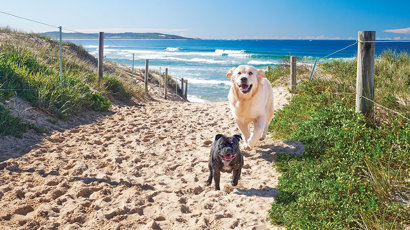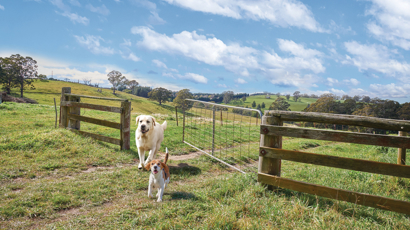How To Get a Shiny Coat on your Dog
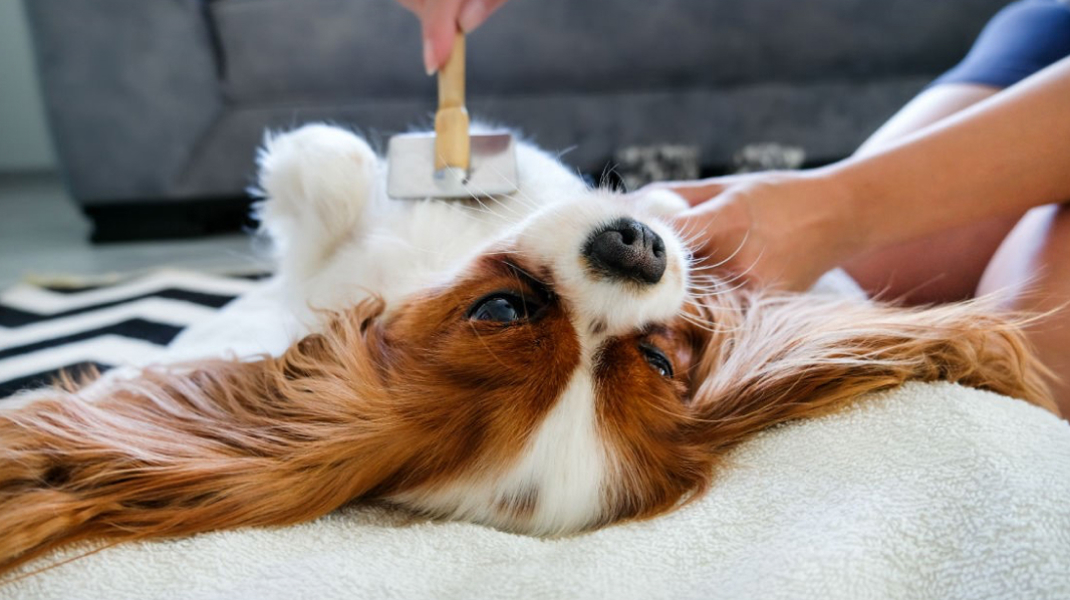
Not only does a gleaming dog coat look and feel great, but it’s also an indicator of overall health. We provide some expert tips to achieve an enviable coat. Words Fiona Park.
A well groomed pooch boasts all-round benefits – fur-free furnishings and a pleasant-smelling dog with a glossy, healthy coat. We talked to Emma Case-Peters of Dogs Show Case in Christchurch, who has been a winner of New Zealand’s Groomer Of The Year, for a few tips and tricks on at-home grooming.
Brushing your Dog
Your dog’s brushing needs will depend on its coat, but generally once a week will suffice. For breeds without strict brushing requirements, Emma says that it can be a matter of personal preference, “it depends how much hair you can tolerate on your carpet – the more you brush, the less will fall out”.
Slicker brushes are a good all-round brush that can be used on most coat types – they have lots of little metal pins that are usually quite soft on the skin. The more pins the brush head has, the less likely it is to get stuck.
When brushing, especially for longer or tangled coats, it’s best to work from the end of the hair to the base, so you don’t end up accidentally tightening any knots.
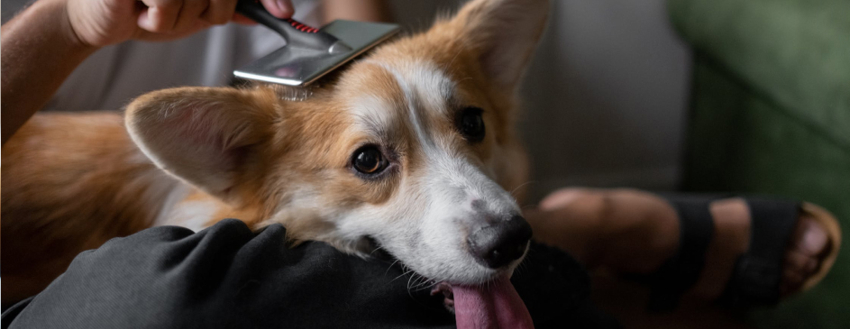
For tangled coats, it can be easier to brush during bath-time, while the conditioner is on.
Washing your Dog
When it comes to bathing, it’ll make your life a lot easier if you have the right set-up for the size of the dog. Smaller dogs are fine in a large sink, but larger ones may need to be washed in the shower, and for dogs that are larger still, there are facilities available at certain pet centres that can accommodate bigger breeds. You’ll need some kind of hose (like a hand-held shower head) so that you can direct the water around the dog’s body, and possibly a non-slip mat.
When dealing with particularly wriggly pooch, it can be useful to slip on a collar and attach it with a short leash to a tap or something secure in the bathing area.
You’ll want to get the dog as wet as possible before lathering up with shampoo. If the dog is quite dirty, you could shampoo twice to make sure the coat is completely clear of debris and grease. Then rinse thoroughly and condition – applying conditioner is an important step as most shampoos tend to remove oils from the coat, so you’ll need to replenish them to keep the cuticles healthy, and not dry and split. Let the conditioner sit for a little bit before rinsing thoroughly.
Tips for Shampooing your Dog
Always read the labels and try to avoid getting shampoo and conditioner in the eyes. Emma recommends using an all-natural shampoo and conditioner, making sure that the label doesn’t require you to wear gloves when applying it to your pooch – if you have to wear gloves to protect your hands, it’s probably not safe enough for your beloved dog. Emma likes Yours Droolly’s Natural Lemon Myrtle Shampoo and Conditioner. Products for human use tend to strip out too many of the natural oils from the coat.
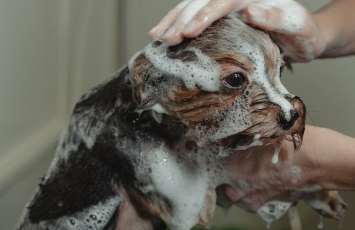
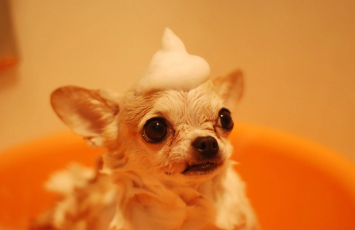
Drying your Dog
If you have a short-haired dog, towel drying may be enough if it’s not too cold. Otherwise, a hair dryer does a great job – it’s just a pity that many dogs dislike them so much!
Use a low heat and power setting, and angle the air along the skin so the hair is blowing in one direction, rather than directly at it with the hair blowing in all directions.
Be sure to continue to move the dryer around, to avoid accidental burns or discomfort. Keep away from the ears and face, as it’s likely your dog won’t like this at first. Dogs naturally dry their heads by vigorously shaking or rubbing on a towel or carpet – this can cause tangles to form, so be sure to brush the head and ears when wet and then later on when dry.
Make sure to dry your dog properly in the cooler months, especially if you have a short-haired pooch, as they can get a chill. Using a dryer is also an excellent aide in fighting knots – the blowing action parts the hair, making it easy to see where knots are forming.
A Shiny Coat from the Inside Out
Coat health starts from the inside out, and that means making sure your pet enjoys a healthy, nutritious diet. Quality proteins and Omega oils play an important role in coat health. Black Hawk pet food is a great choice - it’s specially formulated for canine health, and made with real, natural ingredients - uniquely including Emu oil.
Breed Specific Requirements
Some breeds have specific grooming needs. Dogs with skin folds, like bulldogs, can be harder to properly clean and dry. Try using a little shampoo on a cloth or a make-up pad to get into those hard-to-reach places, make sure to rinse any shampoo off, and take extra care in drying to make sure that no fold is left unturned.
A common gripe of owners of white dogs is tear staining. There are specific products on the market to tackle this, such as Yours Droolly Tear Stain Remover.
Some coats require occasional hand-stripping, extra brushing during shedding seasons, or daily attention, and breeds susceptible to ear infections need extra care. For more specific grooming needs of your dog, talk to a professional certified groomer.
Having your Dog Clipped
Dogs with long coats may need trimming – particularly around the eyes, between the pads of the paw, around the ears and bottom.
Emma recommends seeing a professional certified groomer for this as at-home clipping can be risky, especially if the dog isn’t used to the experience.
If you are set on doing this yourself, electric dog clippers are the safest option. Take it slowly as the dog may take fright at the sound, especially around the head. Ask your professional certified dog groomer if they can provide grooming lessons for you and your dog.
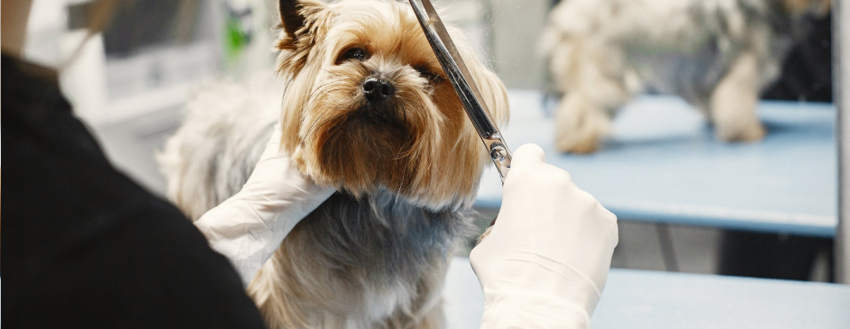
Dogs like poodles don’t shed much hair however the dead hair remains trapped in the curls of the coat so needs to be brushed and trimmed on a regular basis. If the dog is displaying signs of overheating, such as lying on tiles or concrete floors, it’s time for a trim.
Matted Hair
Mats can form because of a variety of reasons – it could be that the dog isn’t getting brushed properly, or that harsh brushes or a poor diet has left the fur weak, dry or broken and susceptible to tangling. Emma has a tip for working out a mat – “use conditioner straight on the knot to make it oily, start from the tip and gently work your way up to the base, holding the mat in your hand when brushing so that you don’t repeatedly brush the dogs sensitive skin but your own hand, so you know how hard the brush is pulling on the skin”.
Sensitive Dogs
If possible, get your dog used to grooming from puppyhood. There are some areas that many dogs find uncomfortable being groomed, such as the paws and ears. Take it slow, be firm and reward the dog for good behaviour. Most dogs will get used to the sensation over time.

